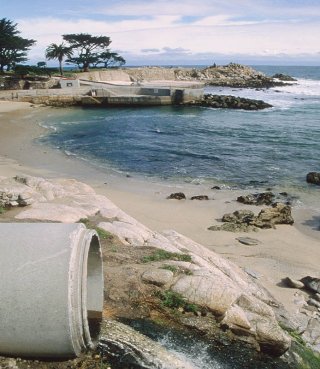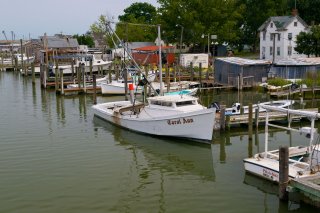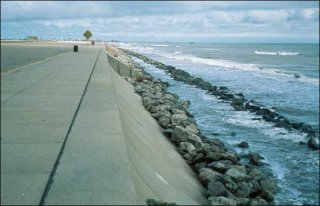What Affects Beach Health

A beach is the sandy, pebbly, or rocky shore of a body of water. Beach types vary widely, especially depending on where they are. When most of us think of a beach, we picture wide open sandy ocean beaches with waves crashing, wind blowing, seagulls flying overhead, and a backdrop of beach grass and sand dunes.
However, beaches in the United States are also found in urban areas, on estuaries and lagoons, and on lakes and rivers. A beach is also a sensitive environment that supports a variety of plants and animals.
Learning more about what negatively affects beach health is the first step to improving the health of our beaches. Pollution, human alteration and impacts from climate change can harm the sensitive beach environment that supports a variety of plants and animals. Beaches can be altered or destroyed if we don't properly protect and learn to enjoy them without harming them.
On this page:
Pollution
Pollution of coastal environments limits our ability to use beaches for economic, recreational and aesthetic purposes. Pollution degrades and destroys unique beach habitat needed by animals and plants. A polluted beach is a public health risk, can reduce property values, and can inhibit economic growth of the community.
Pollution can come from several sources:
- Overflows caused by rain or melting snow
- Runoff from yards, fields, and paved surfaces
- Discharges from ships and boats
- Trash
- Sunscreen
- Harmful Algal Blooms
Overflows caused by rain or melting snow
Water from rain or snowmelt can cause certain types of sewers to overflow if their capacity is exceeded. Discharges from combined sewer overflows (CSOs) and sanitary sewer overflows (SSOs) contain a mixture of raw sewage, industrial wastewater and storm water, and have resulted in beach closings, shellfish bed closings, and aesthetic problems.
Combined sewers are designed to collect rainwater runoff, domestic sewage, and industrial wastewater in the same pipe. Most of the time, combined sewer systems transport all of their wastewater to a sewage treatment plant, where it is treated and then discharged to a water body. During periods of heavy rainfall or snowmelt, however, the wastewater volume in a combined sewer system can exceed the capacity of the sewer system or treatment plant. For this reason, combined sewer systems are designed to overflow occasionally and discharge excess wastewater directly to nearby streams, rivers, or other water bodies.
Sanitary sewer systems are designed to collect and transport all sewage that flows into them to a publicly owned treatment works (POTW). However, occasional unintentional discharges of raw sewage from municipal sanitary sewers occur in almost every system. These types of discharges are called sanitary sewer overflows. SSOs have a variety of causes, including but not limited to blockages, line breaks, sewer defects that allow storm water and groundwater to overload the system, lapses in sewer system operation and maintenance, power failures, inadequate sewer design, and vandalism.

Runoff from yards, fields, and paved surfaces
When rain or snowmelt flows over land or impervious surfaces like paved streets, parking lots, and building roof-tops, it picks up pollutants. Those substances can include bacteria-laden pet waste and animal manure, fertilizers, pesticides, chemicals, gasoline, motor oil, antifreeze, and soil/sediment. The polluted water flows into storm drains, rivers, lakes, streams, and the ocean.
Discharges from ships and boats

Accidental or intentional discharges from all kinds of vessels are a source of pollution that can affect our beaches. Such discharges include trash, fishing gear, ballast water, bilgewater, and water from sinks and showers. The way the EPA controls these discharges depends on the type of vessel: recreational vessels like canoes, kayaks, motorboats, yachts, and sailboats are covered under the Clean Boating Act, and commercial vessels, including those used to transport paying customers, are covered under the Vessel General Permit of the National Pollutant Discharge Elimination System permit program and Coast Guard ballast water regulations.
Trash
Any trash not recycled or properly thrown away can eventually reach our beaches when it is carried by the rain into storm drains, streams, and rivers and then flow into bays and estuaries all the way to the ocean and wash up on the beach. It includes plastic bags, bottles, cans, cigarette filters, bottle caps, and lids. Other sources include people at the beach leaving behind their trash, and fishermen losing or discarding fishing nets and lines in the ocean.
Sunscreen
Common chemicals used in thousands of products to protect against harmful effects of ultraviolet light from the sun can wash off in the water and threaten corals and other marine life like fish, dolphins and mussels.
Harmful Algal Blooms
Harmful algal blooms (HABs) occur when algae grow out of control while producing toxic or harmful effects on people, fish, shellfish, marine mammals, and birds. There are many kinds of HABs, caused by a variety of algal groups with different toxins. The HABs in fresh and marine waters are usually different, but they overlap in low salinity estuaries (places where rivers meet the sea). HABs have been reported in every U.S. coastal state.
Erosion, Habitat Degradation and Sea Level Rise
Human overuse of a beach can gradually degrade it as a habitat for animals and plants. Beach dunes are important natural features because they protect the inland areas and marshes from flooding and storms, and because they provide a unique habitat for many animal and plant species, some of which are threatened or endangered. People walking on the dunes can destroy the plants, which allows the sand to blow away. Waves from boats operating close to the shoreline can also erode the beach.
Coastal and ocean environments, including beaches, are particularly vulnerable to the effects of climate change. Sea level rise due to climate change is a problem that is already affecting coastlines. Beaches, wetlands and estuarine habitats are at risk of becoming inundated or eroded, and may not be able to sustain themselves as the rate of sea level rise accelerates.

Physical structures (seawalls, bulkheads, and other shoreline protection structures) can help prevent beaches from moving inland with the higher water levels. Beaches at risk of inundation by sea level rise or erosion are unable to provide protection for communities along coastlines and important habitat for sea animals, birds and other species.
More frequent extreme weather events due to climate change also increase beach erosion and carry more pollution to beaches from stormwater runoff and wastewater released from damaged infrastructure.
- Learn how communities can improve the resiliency of beaches to climate change: Climate Change Impacts and Adaptation
- Learn how the EPA is working to address climate change impacts on estuaries and coastal areas: Climate Ready Estuaries
